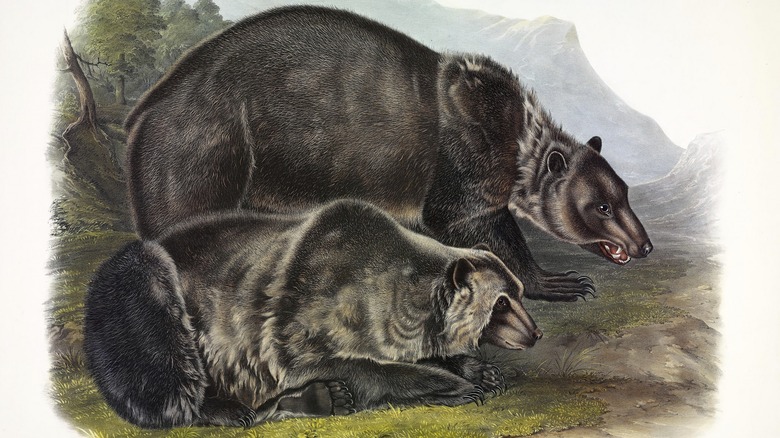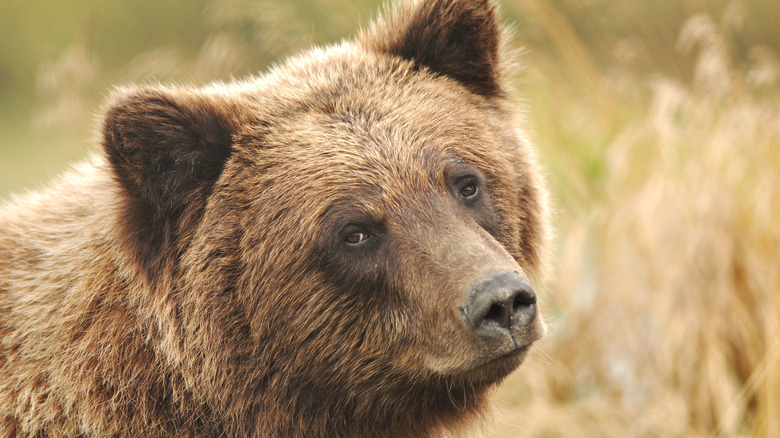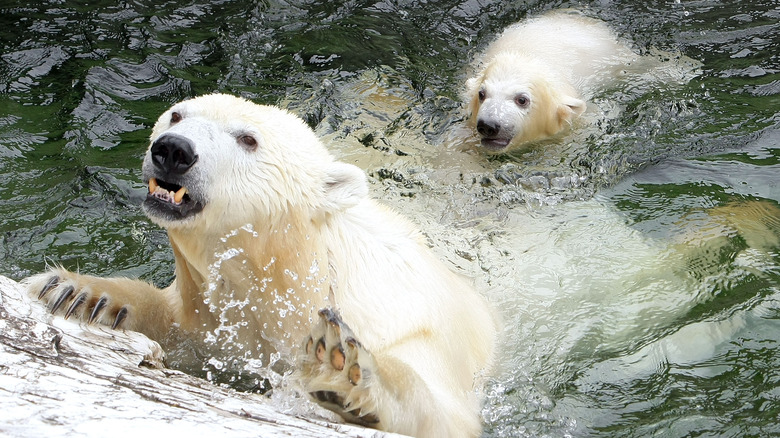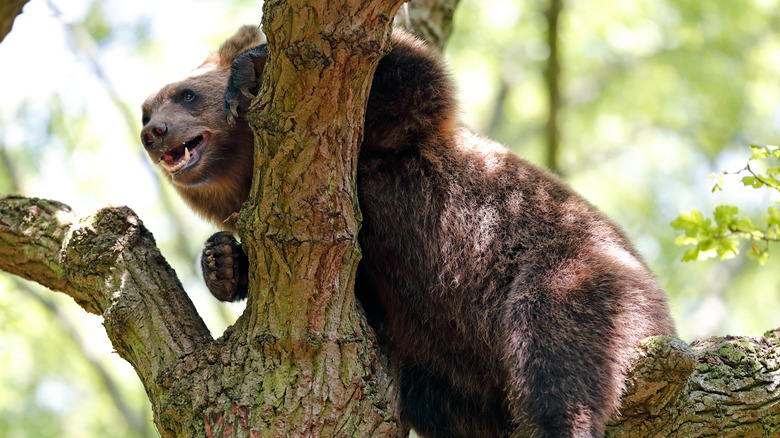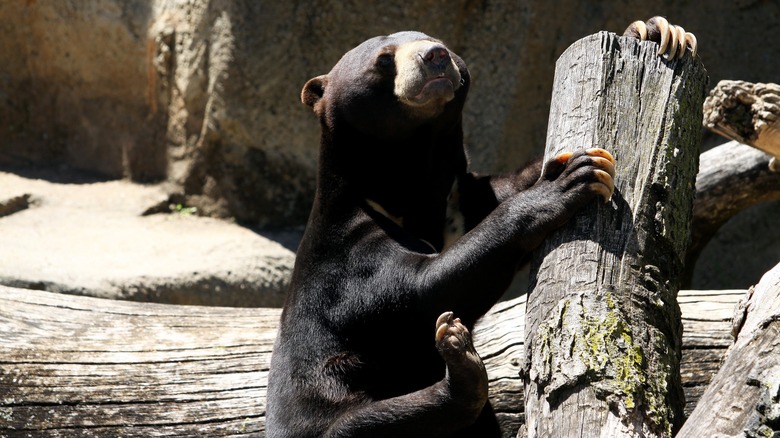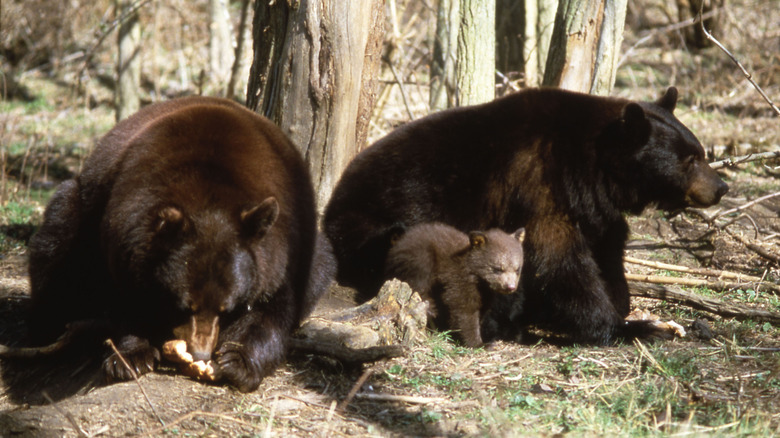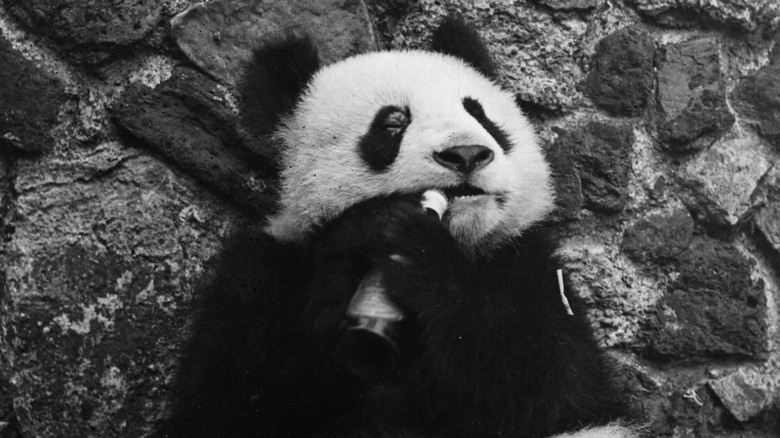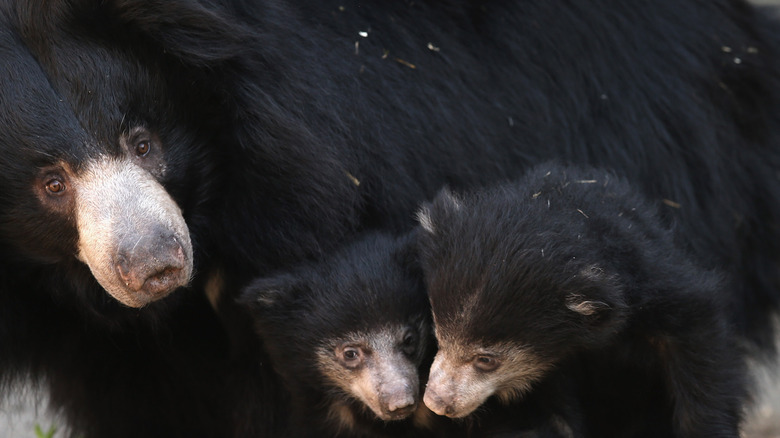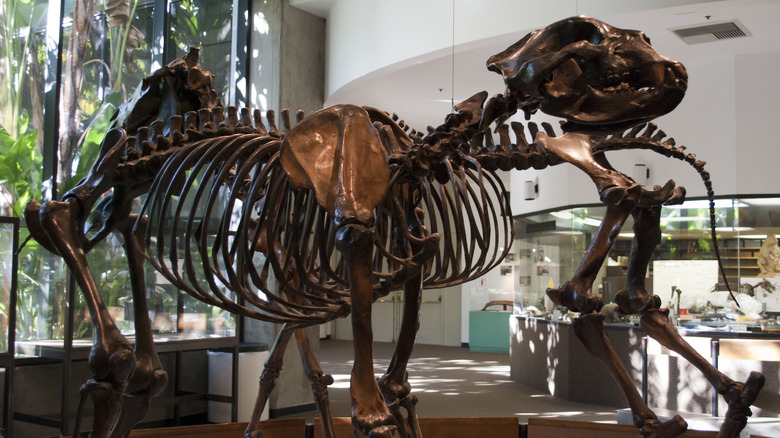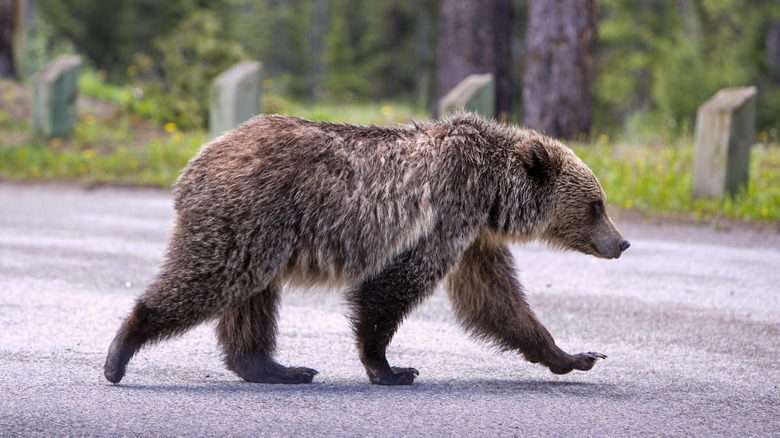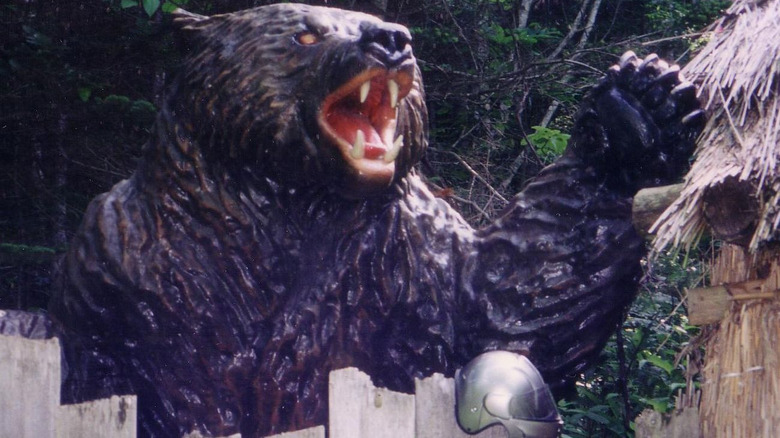The Most Dangerous Bears To Ever Exist
Although not everyone will agree on whether or not bears are cute and cuddly, most people can agree on the fact that a bear is dangerous regardless if you want to cuddle it. Even bears like the panda bear can be downright aggressive. And while ultimately nothing is more dangerous than a human, bears are probably a close second.
Bears evolved around 30 million years ago, and all modern bears are descended from the Ursavus ancestor, which was roughly the size of a sheepdog. Although there were once prehistoric bears that traveled across the globe, now there are only eight different species of bears left in the world. But despite their dwindling numbers, an encounter with a bear may not end well for a human. Even the smallest bear can be deadly, and most species of bears have had recorded instances of human fatalities.
With more and more human-bear encounters due to climate change and human expansion into bear territory, bear attacks are increasing worldwide. And now that the two most dangerous bears have gone and bred and created a pizzly bear, who knows what this new hybrid bear will have in store for humans. For now, these are some of the most dangerous bears to ever exist.
Grizzlies are large and aggressive
Out of all the bears currently living today, the grizzly bear is the most dangerous. Weighing in at over 700 pounds, Daily Collegian writes that grizzlies are primarily more aggressive than black bears since they're too large and don't have the best claws for climbing trees. Thus, when faced with a threat, grizzlies are either going to "stand their ground" or likely end up charging at the threat.
In 2011, Brian Matayoshi and John Wallace were killed two months apart by a grizzly bear, "the first grizzly-caused fatalities in Yellowstone park in 25 years." The New York Times reports that after the same bear was tied to both, the bear in question was euthanized, although there may have been as many as seven bears at the site of the second attack.
More often than not, bears will attack if they perceive a threat. However, they've also been known to wander into areas where they smell food, and in 1967, this led to two tragic encounters in Glacier National Park. After a bear attacked and killed two women at two different campgrounds, many of the park rangers saw it as "an incident waiting to happen," especially considering how some people would throw food to the bears. As a result, the national park set rules on food storage, littering, and instilled a "leave no trace" ethic.
And although it's possible to survive a grizzly bear attack, as of 2020, grizzly bear death rates in the United States are climbing.
A chance encounter with polar bears
Although polar bears don't usually come across humans, when they do they can be deadly. According to the Wildlife Society Bulletin, between 1879 and 2014, there were approximately 73 attacks by wild polar bears, resulting in the deaths of 20 people and over 60 injuries. Polar bears can also be dangerous if you end up eating their liver, which causes vitamin A poisoning in humans.
As The Overcast notes, polar bears are mostly dangerous because they're "skilled apex predators." Upwards of 1,000 pounds, though the largest one can be up to 2,000, they can easily knock a person down with a single hit with their paw, and even the fastest human can't outrun a polar bear. In 2011, Horatio Chappple was killed by a polar bear when he and his fellow British Schools Exploring Society members were attacked during a trip to Svalbard, Norway. In the end, the bear was shot dead by one of the group, and four others were injured by the polar bear.
More and more polar bears are venturing south and coming into contact with humans, and between 2010 and 2014, "there were 15 polar bear attacks on humans, the greatest number ever recorded in a four-year period," notes Yale.
According to Smithsonian Magazine, in some places like Wales, Alaska, people have put together the Kingikmiut Nanuuq Patrol, or the Wales polar bear patrol, which works on "haz[ing] visiting polar bears out of town using an escalating range of non-lethal deterrents."
Brown bear attacks on the rise
Brown bears aren't typically known to attack humans, but as humans continue expanding into bear territory, more and more encounters are occurring in both North America and Russia. Varying in size, a brown bear can be as small as 500 pounds, or as big as 1,500 pounds if it's a large male.
According to the BBC, brown bears in Romania are also proving to be quite dangerous, since in 2019, three men were killed in bear attacks in little over a month. Residents in towns such as Cusma claim that while bears "didn't use to venture into farms to take animals," now they are becoming more brazen and in 2019 took almost 20 cows and pigs, notes Phys.org.
Nature writes that "brown bears are known to adjust their behaviour in order to avoid humans," and in Russia, less than 20% of incidents with bears seems to reflect "predatory behavior." However, "lone bears were involved in more fatalities than female bears with cubs," as was the initial understanding of bear attacks.
As the human population grows all over the world, it becomes more and more difficult for bears to avoid humans. While some countries are seeking to advocate bear hunting, others are seeking to focus more on human-bear coexistence.
The small but deadly sun bear
The sun bear may be the smallest bear, but it makes up for it with its overly aggressive attitude. Weighing in at just under 150 pounds at the most and found primarily in Southeast Asia, sun bears primarily use their long tongues to "extract honey from hives and insects from deep crevices in trees," writes Bears of the World. And unlike other bears, which usually don't attack unless threatened, the sun bear has been known to attack without any provocation and has been described as the most "fierce animals in its range." Between 2000 and 2010, there were 33 deaths due to sun bears in Mizoram, India, alone.
In 2017, Usop Ching and his 9-year-old son Dee Usop were seriously injured after being attacked by a Malayan sun bear near Malaysia's Taman Negara National Park. Peaceful Societies reports that the bear attack lasted almost half an hour until the bear finally left them and ran off into the forest. Due to the deforestation for oil palm plantations, some believe that sun bears are now venturing further out of their usual habitats in search for food, which results in the more frequent encounters with humans.
Sun bears are also targeted by poachers, so it's no wonder that they tend to get vicious around people. For poachers, every part of the sun bear has value, with its meat being sold as food, its claws and teeth sold as souvenirs, and its gallbladder used in medicine.
Black bears find strength in numbers
Located in North America, black bears usually grow to between 125 and 500 pounds. And in general, black bears aren't the most aggressive of bears and have been known to be more likely to scamper up a tree than charge or attack.
According to ABC, most bear-attack incidents end up starting as an encounter with a dog. However, "fatal black bear attacks on humans are so rare — more so than any other species of bear — that they occur on average of once per year across North America." Research shows that between 1900 and 2009, there were 63 fatal black bear attacks in North America.
And according to Smithsonian Magazine, "a greater proportion of fatal attacks occur in the northern parts of the black bear's range, perhaps because these bears are less habituated to people or more food-stressed than southern bears."
However, the rarity of such attacks doesn't make them any more tragic. Once such incident occurred in 2019, when Catherine Sweatt-Mueller was killed by a black bear on Red Pine Island, Ontario, reports the BBC, the first such bear attack in Ontario in almost 15 years. In 2021, a Colorado woman also died as a result of a black bear attack. In both of these incidents, the bears believed to be involved were euthanized.
Panda bears are cute but vicious
No one thinks of panda bears as dangerous, but they can get vicious if they need to because at the end of the day, they're still bears. Although they're typically rather docile and don't usually attack humans or other animals, they have an incredibly powerful bite that can do some serious damage. And while people usually think of the panda as solely snacking on bamboo, they won't shy away from taking a bite out of someone if they're cornered.
This is likely why even though panda attacks in the wild are incredibly rare, there have been a number of recorded attacks by pandas in captivity. According to the International Journal of Clinical and Experimental Medicine, between 2006 and 2009, three people were attacked by a panda at the Beijing City Zoo after ending up in the enclosure, whether on purpose or by accident. In one of the incidents, "the giant panda did not let go of the case's leg even though the victim tried several methods to get the giant panda to release his leg. Only with the help of a zookeeper could the victim escape from the giant panda's bite."
And even if they don't mean it, the bite can still pack a punch. According to The Guardian, after a giant panda was chased onto Guan Quanzhi's land and bit him in the leg, Guan ended up needing seven hours of surgery to address his injuries. After suing local officials, Guan "won more than $80,000 in compensation."
Sloth bears are unusually aggressive
Although sloth bears weigh less than 500 pounds, they can be exceptionally fierce. One such sloth bear became famous as the Sloth Bear of Mysore after killing at least 12 people and injuring over 30 others near Bengaluru, India, in 1957. According to Dark Tales, this bear became especially aggressive when encountering humans and often attacked people's faces, "resulting in the face being completely torn from the skull in a number of cases."
British hunter Kenneth Anderson was called to execute the bear, although it took over a month for him to track down the bear, resulting in several more bear attacks in the meantime. And even though sloth bears "normally [have] little meat in its diet," at least three of its human victims showed signs of being "partially eaten."
However, despite the fame of the Sloth Bear of Mysore, sloth bears in India actually attack people with a startling regularity. National Geographic writes that the sloth bear may actually be considered the world's deadliest bear, since although the Indian government doesn't keep any kind of record of fatal attacks at a federal level, the sloth bear is "responsible for more human fatalities per capita than any other type of bear." Thousands of people have been mauled by sloth bears in the 21st century, and hundreds of people have lost their lives as a result of a sloth bear attack.
The largest bear in history
The South American giant short-faced bear, also known as Arctotherium angustidens, may not be around anymore, but at one point it must have absolutely struck fear into the hearts of our human ancestors. The giant short-faced bear stood at over 11 feet tall and weighed between 3,500 and 4,000 pounds, according to LiveScience. And unlike modern bears, which are "pigeon-toed," these bears had toes which "pointed straight forward, enabling it to walk with a fast, purposeful gait." Honestly, what's more terrifying than the thought of an 11-foot tall bear walking furiously towards you?
ThoughtCo notes that although the prehistoric cave bear is more popular, this giant short-faced bear was likely more of a menace, since its diet consisted solely of meat, while the cave bear was a "strict vegetarian." And although North American giant short-faced bears grew bigger over time, for a time the South American giant short-faced bear was the "king of the continent," notes National Geographic.
Although some have suggested that the giant short-faced bear was a scavenger that took advantage of already-hunted prey, its dental records suggest that the giant short-faced bear was all too familiar with the "acquisition of largest prey abundant on Pleistocene landscapes" (via the National Center for Biotechnology Information). And since it's estimated that it may have needed up to 50 pounds of meat per day to survive, it's unlikely that it was able to come up with all that meat via scavenging, so it's safe to say that humans were probably part of the menu.
It's not always the bears you know
In the 2005 documentary film, "Grizzly Man," Werner Herzog takes a look at the life of Timothy Treadwell, which came to a tragic end in 2003, when he and his girlfriend, Amie Huguenard, were killed by a bear in Katmai National Park and Reserve in Alaska.
During his time at the national park, Treadwell developed a relationship with several bears after spending almost 35,000 hours with the animals over the course of 13 years, according to Mental Floss. So although some people have disparaged Treadwell for putting himself in a dangerous situation, given all of his experience with bears, he probably wasn't acting like a novice. However, despite all his experience around bears, there's always going to be a bear that you don't know, and no matter how careful you are, you'll never know what it's thinking or going to do.
Tragically, that's exactly what happened to Treadwell and Huguenard when they were attacked by an unfamiliar bear in Katmai National Park and Reserve, who came to be known as Bear 141. Bear 141 was euthanized after the attack along with another nearby bear, and the evidence of human remains inside Bear 141's stomach seemed to confirm that it was responsible for the death of Treadwell and Huguenard.
This ended up being the first time in 85 years that someone had been killed by a grizzly bear in Katmai National Park and Reserve.
The worst bear attack in Japanese history
One of the worst bear attacks in history occurred in Sankebetsu Rokusen-Sawa, Japan, in 1915, when seven people were killed by a bear known as Kesagake. The Vintage News writes that the tragic events began in mid-November when a brown bear showed up at the Ikeda family's front door. Initially, the bear simply took some corn and left. But on November 20, when the bear returned, this time the Ikeda family called some friends and shot at the bear trying to drive it away, wounding it.
They hoped that would be the end of it, but they were tragically wrong. On the morning of December 9, the bear reappeared at the Ota family home and attacked those inside, Abe Mayu and a baby she was babysitting.
Villagers again shot at the bear and wounded it, but once more it managed to escape. Later that night, sneaking past the numerous guards, the bear went into the Miyouke family household and attacked, leading to the deaths of two children, a pregnant woman, and one of the guards.
After this attack, villagers became convinced that the bear was one known as Kesagake, who had "previously killed three women," and assembled a hunting party to track down Kesagake. It took several days, but finally on December 14, 1915, Kesagake was shot and killed. Unfortunately, soon after "Rokusen Sawa became a ghost town, as many of the villagers left in fear of more bear attacks."
